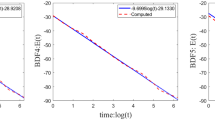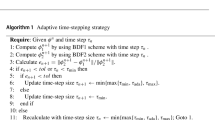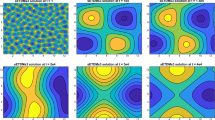Abstract
In this work, we are concerned with the stability and convergence analysis of the second-order backward difference formula (BDF2) with variable steps for the molecular beam epitaxial model without slope selection. We first show that the variable-step BDF2 scheme is convex and uniquely solvable under a weak time-step constraint. Then we show that it preserves an energy dissipation law if the adjacent time-step ratios satisfy rk:= τk/τk−1 < 3.561. Moreover, with a novel discrete orthogonal convolution kernels argument and some new estimates on the corresponding positive definite quadratic forms, the L2 norm stability and rigorous error estimates are established, under the same step-ratio constraint that ensures the energy stability, i.e., 0 < rk < 3.561. This is known to be the best result in the literature. We finally adopt an adaptive time-step** strategy to accelerate the computations of the steady state solution and confirm our theoretical findings by numerical examples.
Similar content being viewed by others
References
Amar J-G, Family F. Effects of crystalline microstructure on epitaxial growth. Phys Rev B, 1996, 54: 14742–14753
Becker J. A second order backward difference method with variable steps for a parabolic problem. BIT, 1998, 38: 644–662
Chen W, Conde S, Wang C, et al. A linear energy stable scheme for a thin film model without slope selection. J Sci Comput, 2012, 52: 546–562
Chen W, Wang C, Wang X. A linear iteration algorithm for a second-order energy stable scheme for a thin film model without slope selection. J Sci Comput, 2014, 59: 574–601
Chen W, Wang X, Yang Y, et al. A second order BDF numerical scheme with variable steps for the Cahn-Hilliard equation. SIAM J Numer Anal, 2019, 57: 495–525
Cheng Q, Shen J, Yang X-F. Highly efficient and accurate numerical schemes for the epitaxial thin film growth models by using the SAV approach. J Sci Comput, 2019, 78: 1467–1487
Crouzeix M, Lisbona F-J. The convergence of variable-stepsize, variable formula, multistep methods. SIAM J Numer Anal, 1984, 21: 512–534
Emmrich E. Stability and error of the variable two-step BDF for semilinear parabolic problems. J Appl Math Comput, 2005, 19: 33–55
Evans J-W, Thiel P-A. A little chemistry helps the big get bigger. Science, 2010, 330: 599–600
Golubovic L. Interfacial coarsening in epitaxial growth models without slope selection. Phys Rev Lett, 1997, 78: 90–93
Gomez H, Hughes T. Provably unconditionally stable, second-order time-accurate, mixed variational methods for phase-field models. J Comput Phys, 2011, 230: 5310–5327
Gong Y Z, Zhao J, Wang Q. Arbitrarily high-order unconditionally energy stable schemes for thermodynamically consistent gradient flow models. SIAM J Sci Comput, 2020, 42: 135–156
Grigorieff R-D. Stability of multistep-methods on variable grids. Numer Math, 1983, 42: 359–377
Ju L, Li X, Qiao Z, et al. Energy stability and error estimates of exponential time differencing schemes for the epitaxial growth model without slope selection. Math Comp, 2018, 87: 1859–1885
Le Roux M-N. Variable step size multistep methods for parabolic problems. SIAM J Numer Anal, 1982, 19: 725–741
Li B, Liu J-G. Thin film epitaxy with or without slope selection. European J Appl Math, 2003, 14: 713–743
Liao H-L, Ji B, Zhang L. An adaptive BDF2 implicit time-step** method for the phase field crystal model. IMA J Numer Anal, 2020, doi:https://doi.org/10.1093/imanum/draa075
Liao H-L, Tang T, Zhou T. On energy stable, maximum-principle preserving, second order BDF scheme with variable steps for the Allen-Cahn equation. SIAM J Numer Anal, 2020, 58: 2294–2314
Liao H-L, Zhang Z. Analysis of adaptive BDF2 scheme for diffusion equations. Math Comp, 2020, doi:https://doi.org/10.1090/mcom/3585
Qiao Z, Sun Z-Z, Zhang Z. Stability and convergence of second-order schemes for the nonlinear epitaxial growth model without slope selection. Math Comp, 2015, 84: 653–674
Qiao Z, Zhang Z, Tang T. An adaptive time-step** strategy for the molecular beam epitaxy models. SIAM J Sci Comput, 2011, 33: 1395–1414
Rost M, Krug J. Coarsening of surface structures in unstable epitaxial growth. Phys Rev E (3), 1997, 55: 3952–3957
Shen J, Wang C, Wang X, et al. Second-order convex splitting schemes for gradient flows with Ehrlich-Schwoebel type energy: Application to thin film epitaxy. SIAM J Numer Anal, 2012, 50: 105–125
Xu C, Tang T. Stability analysis of large time-step** methods for epitaxial growth models. SIAM J Numer Anal. 2006, 44: 1759–1779
Xu J, Li Y-K, Wu S-N, et al. On the stability and accuracy of partially and fully implicit schemes for phase field modeling. Comput Methods Appl Mech Engrg, 2019, 345: 826–853
Yang X-F, Zhao J, Wang Q. Numerical approximations for the molecular beam epitaxial growth model based on the invariant energy quadratization method. J Comput Phys, 2017, 333: 104–127
Zhang Z, Ma Y, Qiao Z. An adaptive time-step** strategy for solving the phase field crystal model. J Comput Phys, 2013, 249: 204–215
Acknowledgements
The first and second authors were supported by National Natural Science Foundation of China (Grant No. 12071216). The third author was supported by National Natural Science Foundation of China (Grant No. 11731006) and the NNW2018-ZT4A06 project. The fourth author was supported by National Natural Science Foundation of China (Grant Nos. 11822111, 11688101 and 11731006) and the Science Challenge Project (Grant No. TZ2018001). The authors thank the anonymous referees for their valuable comments that are very helpful in improving the quality of this article (ar**v:2008.03185v1).
Author information
Authors and Affiliations
Corresponding author
Rights and permissions
About this article
Cite this article
Liao, HL., Song, X., Tang, T. et al. Analysis of the second-order BDF scheme with variable steps for the molecular beam epitaxial model without slope selection. Sci. China Math. 64, 887–902 (2021). https://doi.org/10.1007/s11425-020-1817-4
Received:
Accepted:
Published:
Issue Date:
DOI: https://doi.org/10.1007/s11425-020-1817-4
Keywords
- molecular beam epitaxial growth
- variable-step BDF2 scheme
- discrete orthogonal convolution kernels
- energy stability
- convergence analysis




